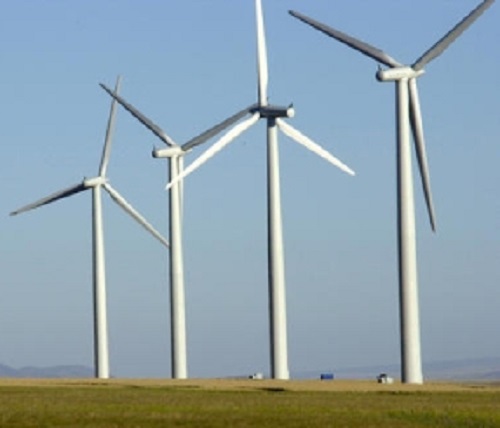Energy
How ‘Green’ projects are looting the treasury

From the Frontier Centre for Public Policy
All that money is wasted. Wind and solar and the various battery projects have not managed to support the electrical grid in any substantial way, hovering, on average, around 4 percent.
The most egregious theft of collective wealth and well-being — and it is flat-out theft — is the churn on “alternative” forms of energy production. Senator Tommy Tuberville of Alabama said last week in an interview with Steve Bannon that the U.S. has spent some $7 trillion over budget in the last three years, and 25 percent of that went to “climate change” projects. They are all like Solyndra, massively subsidized and within a decade, massive failures. “The investors take a tax loss,” said Tuberville, “then move onto the next effort where they again loot the public.” This is salted through all the investment banks, retirement accounts. It represents all putative growth.
In June of 2023, the Department of Energy admitted that it had allocated $1.3 trillion for “clean energy” investment support since 2020, and that spending rose 25 percent from 2021-23. This is a fraction of what was really spent. Further, this money is not only based in debt, thus raising inflation, but it is also raising energy prices. It is the principal reason that almost 25 percent of us, according to economist Peter St. Onge, have been forced to choose between heat and food this winter.
What a choice.
$1,750,000,000, in an annual gift to the rich. The World Economic Forum projects that climate spending in the U.S. will triple over the next ten years. Biden’s “climate” budget is $5.7 trillion. Triple that to $20 trillion. No wonder the market is booming. The U.S. has pledged another half a trillion in “low carbon electricity” under this year’s Paris Climate Accord. And further:
- Among all measures tracked since 2020, direct incentives for manufacturers aimed at bolstering domestic manufacturing of “clean” energy now total to around $90 billion.
- Since the start of the global energy crisis, governments have also allocated $900 billion to short-term consumer affordability measures, additional to pre-existing support programs and subsidies. Around 30 percent of this “affordability” spending has been announced in the past six months, and despite calls to better target households and industries most in need, only 25 percent of affordability measures are targeted towards low-income households and most-impacted industries.
Much of this last $900 billion is direct subsidy to the wealthy in annual subsidies for clean energy. This is again, annual subsidy, so look at the last twenty years. President Obama started this program, therefore, we are looking at a $10 – $ 20 trillion gift to the rich since the Lightbringer took office. What is not counted in these budgets are the losses that accrue from the failure of “green energy” projects, which is the taxpayer’s loss.
Last year, investors in Spain’s green energy collapse took the government to court to claw back subsidies from a dead industry in a country with a debt 400 percent larger than GDP. No wonder millions on the street want to outlaw socialism. As is clear from Spain, when the government runs out of money the first thing to go is the subsidy to green energy, after which the enterprise fails immediately.
In my neck of the Canadian woods, you can install a solar system for $20,000, and get a 25 percent subsidy, as does the installer whose business the government created via “free” “investment.” I live in a rain forest. Which means solar is not available during winter rains and not needed during the summers. Recently everyone with a few extra bucks has taken up the government offer to install heat pumps, also subsidized by between 50 percent and 75 percent. Rain forests mean hydro power, which is essentially, greenhouse-gas-free, and the most inexpensive “fuel,” but an almost-free heat pump? Again win/win for the upper-middle-class because no one in Canada’s increasingly massive working class can afford it.
This model was invented by politicians in power. The first person to notice it was Peter Schweizer; in Throw Them All Out, he details the billionaire investors who funded Obama and who were cashed out via various solar and wind projects. Hundreds of billions of dollars went missing on Obama’s various “clean energy” projects.
This year, every government department is “investing” in clean energy, vis, a quick Google search, will show. Pages and pages of boastful press releases follow. Every agency is in on the boondoggle. NOAA, the National Oceanic and Atmospheric Administration, and the U.S. Patent and Trade Mark Office have signed a collaborative agreement to advance climate technology. Putting aside the fact that “climate change” is neither imminent nor dangerous, the government should not be creating patents. Innovation should be carried out by the private market, where there are controls.
As we discovered during Covid, government patents on both the virus and the vaccine were not subjected to court challenge, double blind testing, or feasibility. There is no number attached to NOAA’s “initiative,” but this is representative of ten thousand such projects salted through every government bureau. All that money is wasted. Wind and solar and the various battery projects have not managed to support the electrical grid in any substantial way, hovering, on average, around 4 percent. Despite this mind-boggling waste of money, in September last year former New York City mayor Michael Bloomberg pledged another $500 billion to shutter the equivalent of 40 percent total electricity use of nine states, including California, Florida, New York, Illinois and Texas.
What has been the result of trillions of public money shunted into “clean” “green” “energy” on the actual energy grid? Robert Bryce, an acknowledged expert, shows that it is failing. A speech he gave at the winter meeting of the National Association of Regulatory Utility Commissioners showed astonishing, across the-board failure in every metric you can imagine.
“Climate Policy” is considered the most significant risk. As Bryce describes, “green energy” has meant Europe is deindustrializing, Ford lost $64,731 for every EV it sold, and the IEA states that global coal use will hit another new record of 8.5 billion tons. Coal use increased 35 percent in last summer’s heat wave. Wind dropped by 21 percent.
Climate policy breaks everything. It breaks communities, it encourages widespread theft of public money, it starves productive work and manufacturing, it has punched down on the less advantaged, and it is destroying the fabric of our lives. And for what?
First published in thepipeline.org, March 24, 2024.
Elizabeth Nickson is a Senior Fellow at the Frontier Centre for Public Policy.
Energy
Canada following Europe’s stumble by ignoring energy reality

Family in Spain eating by candlelight during a blackout, April 2025
From Resource Works
Canada’s own 2024 grid scare proves we’re on the same path unless we change course.
Europe’s green-energy unraveling is no longer a distant cautionary tale. It’s a mirror — and Canada is already seeing the first cracks.
A new Wall Street Journal investigation lays out the European story in stark detail: a continent that slashed emissions faster than anyone else, only to discover that doing so by tearing down firm power before its replacement existed comes with brutal consequences — collapsing industry, sky-high electricity prices, political fragmentation, and a public increasingly unwilling to subsidize wishful thinking.
The tragedy isn’t that Europe tried to decarbonize quickly.
The tragedy is how they did it: by insisting on an “or” transition — renewables or fossil fuels — instead of what every energy-literate nation outside Europe pursued: renewables and fossil fuels, working together while the system evolves.
And here’s the uncomfortable truth:
Canada has already had its first European-style crisis. It happened in January 2024.
Canada’s early warning: the January 2024 electricity crunch
Most people have already forgotten it, because our political class desperately wanted you to. But in January 2024, Western Canada came within a whisker of a full-blown energy security breakdown. Alberta, Saskatchewan, and B.C. were stretched to their limit. The grid was under cascading stress. Contingency plans were activated. Alberta came terrifyingly close to rolling blackouts.
It wasn’t caused by climate change. It wasn’t caused by a mysterious cyberattack.
It was caused by the same structural brittleness now crippling Europe:
- Insufficient firm power, after years of political messaging that we could “electrify everything” without adding real generating capacity.
- Overreliance on intermittent sources not backed by storage or gas.
- A planning system that punted risk into the future, betting the grid could be stretched indefinitely.
The January 2024 event was not a blip. It was a preview.
Our European moment in miniature.
But instead of treating it as the national wake-up call it should have been, B.C. did something telling — and deeply damaging.
The B.C. government’s response: attack the messenger
Just a couple of years ago, an economist publicly warned about the economic price of emerging system vulnerabilities due to a groaning stack of “clean economy” policies.
The B.C. government didn’t respond with data, evidence, or even curiosity. Instead, a cabinet minister used the safety of legislative privilege — that gold-plated shield against accountability — to launch nasty personal attacks on the economist who raised the concerns, which themselves had originated in the government’s own analysis.
No engagement.
No counter-analysis.
No willingness to consider the system risks.
Just slurs — the very definition of anti-intellectual governance.
It was a moment that told the whole story:
Too many policymakers in this province believe that energy systems obey politics, not physics.
Physics always gets the last word.
Europe shows us what political denial turns into
The WSJ reporting couldn’t be clearer about the consequences of that denial:
- Germany: highest domestic electricity prices in the developed world.
- U.K.: highest industrial electricity rates among major economies.
- Industrial flight: chemical plants closing, data centres frozen, major players hinting at exiting Europe entirely.
- Grid instability: wind farms paid tens of millions not to generate because the grid can’t handle it.
- Public revolt: rising support for parties rejecting the entire green-transition agenda.
- Policy whiplash: governments rushing to build gas plants they swore they’d never need.
Europe is now an object lesson in how good intentions, executed poorly, can produce the exact opposite of what was promised: higher prices, higher volatility, declining competitiveness, and a public ready to abandon climate policy altogether.
This is precisely what January 2024 warned us about — but on a continental scale.
The system cost we keep pretending doesn’t exist
Every serious energy expert knows the truth Europe is now living: intermittent renewables require massive amounts of redundant capacity, storage, and backup generation. That’s why the U.K. now needs 120 gigawatts of capacity to serve a demand previously met with 60–70 gigawatts, even though electricity use hasn’t meaningfully grown.
This is the math policymakers prefer not to show the public.
And it’s why B.C.’s refusal to have an honest conversation about firm power is so dangerous.
If we electrify everything without ensuring affordable and abundant natural gas generation, we’re not building a green future.
We’re building Europe, 10 years early.
The lesson for Canada — especially for B.C.
Here is what Europe and January 2024 together say, in one clear voice:
1. There is no energy transition without firm power.
Renewables are part of the system, but they don’t run the system. Natural gas does. Hydro does. Nuclear does. Pretending otherwise is how you end up with rolling blackouts.
2. Political denial makes crises worse.
When ministers attack economists instead of answering them, it signals that ideology is running the show. Europe learned the cost of that. We will too, unless we change course.
3. Affordability is the foundation of public consent.
Europe lost the room. Once people see their bills double while factories close, the climate agenda becomes politically radioactive.
4. B.C. has an advantage Europe would kill for.
Europe dreams of having an abundant, local, low-carbon firm-power fuel like northeastern B.C.’s natural gas. We treat it like a political liability. That’s not strategy. It’s negligence.
5. The transition will fail if we don’t treat electricity like the national security asset it is.
Without energy, there is no industry.
Without industry, there is no prosperity.
Without prosperity, there is no climate policy that survives the next election cycle.
What we need now
Canada must embrace an “and” strategy:
Renewables and natural gas. Electrification and realism. Climate ambition and economic competitiveness.
January 2024 showed us the future in a flash. Europe shows us the end state if we keep ignoring the warning.
We can still choose something better. But only if we stop pretending that energy systems bend to political narratives — and start treating them with the seriousness they demand.
Resource Works News
Alberta
Carney’s pipeline deal hits a wall in B.C.

This article supplied by Troy Media.
Carney’s attempt to ease Canada’s dependence on the U.S. stirs a backlash in B.C., raises Indigenous concerns and rattles his own party
The Memorandum of Understanding (MOU) between Prime Minister Mark Carney and Alberta Premier Danielle Smith has opened a political hornet’s nest, exposing deep divisions within the Liberal Party and forcing a national debate that has been avoided for years.
Carney was under mounting pressure to respond to U.S. tariffs that threaten to carve billions out of Canada’s economy. The United States buys more than 95 per cent of Canada’s oil exports, leaving the country highly exposed to U.S. policy decisions. That pressure is now driving his push for a route to the Pacific, a project that could change Canada’s economic future but also destabilize his already fragile minority government.
Carney knows the political risk. His government could fall at any time, which only raises the stakes. Even so, he has pressed ahead. The agreement with Alberta lays early groundwork for a new pipeline to the Pacific. It would expand the oil sands, ease some environmental obligations and revive a proposal industry leaders have pushed for years.
The route is far from settled, but it is expected to run to B.C.’s northern coast and open access to Asian buyers. A Pacific route would finally give Canada a direct path into Asian energy markets, where demand remains strong and prices are often higher than in the United States.
If Carney expected broad support, he did not get it, especially in British Columbia. Because B.C. is the only province with a deep-water port capable of handling large crude carriers, it is the only path a west-coast pipeline can take. The province is now the central battleground, and whether the project succeeds will depend on what happens there.
B.C. Premier David Eby criticized the lack of consultation. “It would have been good for B.C. to be at the table,” he said, warning that the project risks undermining Indigenous support for the province’s liquefied natural gas plans. He also noted that the pipeline has no private backer and no commitments from First Nations, two obstacles that have tripped up projects before.
The backlash quickly spread to Ottawa. Steven Guilbeault, the former environment minister and the most prominent environmentalist ever to serve in a federal cabinet, resigned from cabinet in direct response to the MOU. He said the proposed pipeline “would have major environmental impacts”. Green Party Leader Elizabeth May said his departure “dashes the last hope that Mark Carney is going to have a good climate record ever.”
Several B.C. Liberal MPs echoed concerns about the political cost. CBC News reported anger inside the caucus, with some MPs “seething” over the agreement and worried about losing climate-focused voters.
The voters those MPs fear may not be as opposed as they think. An October Angus Reid Institute survey found that a solid majority of Canadians support a pipeline from northern Alberta to the northwest B.C. coast. In British Columbia, support outweighs opposition by a wide margin. That challenges Eby’s claim that the project lacks public backing. Carney may have more room to manoeuvre than his critics admit.
The most significant challenge, however, comes from Indigenous leaders. British Columbia is the only province that has formally adopted the United Nations Declaration on the Rights of Indigenous Peoples (UNDRIP) into law, giving First Nations a stronger legal position in major project decisions. Court rulings over the past two decades have affirmed a duty to consult and, in some cases, accommodate Indigenous communities, giving them major influence over large projects.
A group representing Coastal First Nations in B.C. said the pipeline “will never happen”. The Union of B.C. Indian Chiefs said it is “loudly objecting” to the MOU, arguing it was drafted without involvement from coastal First Nations and does not meet consultation standards outlined in UNDRIP. “The answer is still no and always will be,” said UBCIC Grand Chief Stewart Phillip. He also said lifting the crude oil tanker ban would amount to bulldozing First Nation rights. Without Indigenous consent, the project cannot proceed, and Carney knows this is the single largest barrier he faces.
Carney’s reasoning is straightforward. The long-term danger of relying on one market outweighs the short-term turbulence created by the pipeline fight. The MOU suggests Ottawa is prepared to reconsider projects once thought politically impossible in order to protect Canada’s economic future. He is betting that doing nothing is the bigger risk.
Whether this pipeline moves forward is uncertain, and the obstacles are real. One fact, however, remains clear. Canada cannot keep betting its stability on a single market.
Toronto-based Rashid Husain Syed is a highly regarded analyst specializing in energy and politics, particularly in the Middle East. In addition to his contributions to local and international newspapers, Rashid frequently lends his expertise as a speaker at global conferences. Organizations such as the Department of Energy in Washington and the International Energy Agency in Paris have sought his insights on global energy matters.
Troy Media empowers Canadian community news outlets by providing independent, insightful analysis and commentary. Our mission is to support local media in helping Canadians stay informed and engaged by delivering reliable content that strengthens community connections and deepens understanding across the country.
-

 Business1 day ago
Business1 day agoRecent price declines don’t solve Toronto’s housing affordability crisis
-

 Daily Caller1 day ago
Daily Caller1 day agoTech Mogul Gives $6 Billion To 25 Million Kids To Boost Trump Investment Accounts
-

 National1 day ago
National1 day agoCanada Needs an Alternative to Carney’s One Man Show
-

 Alberta1 day ago
Alberta1 day agoAlberta will defend law-abiding gun owners who defend themselves
-

 Artificial Intelligence2 days ago
Artificial Intelligence2 days agoThe Emptiness Inside: Why Large Language Models Can’t Think – and Never Will
-

 Business1 day ago
Business1 day agoOttawa’s gun ‘buyback’ program will cost billions—and for no good reason
-

 Business1 day ago
Business1 day agoCanada’s future prosperity runs through the northwest coast
-

 Alberta18 hours ago
Alberta18 hours agoThis new Canada–Alberta pipeline agreement will cost you more than you think







